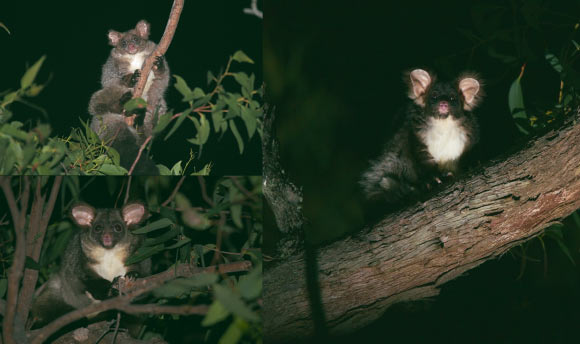The greater glider (Petauroides volans), a large, nocturnal gliding marsupial endemic to Australia, isn’t one species, but rather three distinct ones.

Petauroides minor (top left), Petauroides armillatus (bottom left) and Petauroides volans (right) greater gliders. Image credit: Denise McGregor / Jasmine Vink.
Greater gliders have a widespread distribution primarily associated with eucalypt forests along Australia’s Great Dividing Range from northern Queensland to southern Victoria.
Strictly tree-dwelling, they are vulnerable to habitat loss and disturbance due to their specialized diet of eucalypt leaves and obligate dependence on mature trees with large hollows for shelter.
“There has been speculation for a while that there was more than one species of greater glider, but now we have proof from the DNA,” said first author Denise McGregor, a Ph.D. student in the College of Science and Engineering at James Cook University.
“It changes the whole way we think about them.”
“Australia’s biodiversity just got a lot richer,” said co-author Professor Andrew Krockenberge, a researcher in the Division of Research and Innovation at James Cook University.
“It’s not every day that new mammals are confirmed, let alone two new mammals.”
“Differences in size and physiology gave us hints that the one accepted species was actually three.”
“For the first time, we were able to use diversity arrays (DArT) sequencing to provide genetic support for multiple species.”
The scientists found that northern, central and southern greater glider populations are morphologically and genetically distinct and should be separated into three different species: Petauroides minor, Petauroides armillatus and Petauroides volans.
“The identification and classification of species are essential for effective conservation management,” said senior author Dr. Kara Youngentob, a researcher in the Research School of Biology at Australian National University.
“This year Australia experienced a bushfire season of unprecedented severity, resulting in widespread habitat loss and mortality. As a result, there’s been an increased focus on understanding genetic diversity and structure of species to protect resilience in the face of climate change.”
“The division of the greater glider into multiple species reduces the previous widespread distribution of the original species, further increasing conservation concern for that animal and highlighting the lack of information about the other greater glider species.”
“There have been alarming declines in greater glider populations in the Blue Mountains, New South Wales and Central Highlands, Victoria and localized extinctions in other areas.”
“The knowledge that there is now genetic support for multiple species, with distributions that are much smaller than the range of the previously recognized single species, should be a consideration in future conservation status decisions and management legislation.”
The findings were published in the journal Scientific Reports.
_____
D.C. McGregor et al. 2020. Genetic evidence supports three previously described species of greater glider, Petauroides volans, P. minor, and P. armillatus. Sci Rep 10, 19284; doi: 10.1038/s41598-020-76364-z







